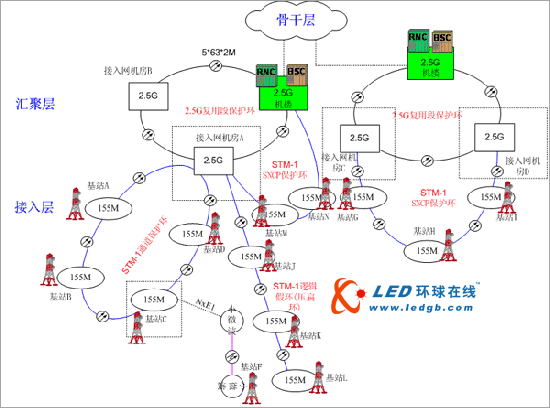The layered structure of the transmission network in the telecommunications network originally has three levels: backbone transmission network, local transmission network and access network. Later, the concept of the metropolitan area network was also introduced into the field of transmission network. Some are called metropolitan transport networks.
The previous transport network used the SDH-based multi-service transport platform MSTP technology, which is mainly used for the base station bearer of the radio access network (RAN), and also takes care of the transmission requirements of services such as dedicated lines and TDM circuits.
Figure 1 SDH / MSTP technical solution used by China Mobile's 2G base station backhaul
In the past, in order to meet the high-quality transmission requirements of GSM base station access, China Mobile has established a relatively complete metropolitan transmission network. The metropolitan transport network can be logically divided into three levels: core layer, convergence layer and access layer, as shown in Figure 1. The backbone nodes are composed of exchange offices, gateway offices, long-distance offices, and data center nodes, forming a core layer; generally, metropolitan WDM or 10G / 2.5G SDH equipment is used to form a ring network (mesh networks are used in some areas). The aggregation node is composed of important bureaus and data aggregation points to form an aggregation layer; it is mainly based on 2.5G SDH / MSTP equipment, supplemented by a small number of 622M / 155M SDH / MSTP equipment, and forms a ring network (using the multiplex section protection method) ). The access node is composed of base stations, community broadband network services and other business access points, forming an access layer; mainly adopts 622M / 155M SDH / MSTP equipment, supplemented by PDH, microwave, 3.5G or other wireless access technologies, mainly Group ring network (usually adopting channel protection method) can also adopt star, tree or chain structure according to the access optical fiber route.

In the past, SDH has played a powerful backing role in the process of China Mobile shaping the "premium network" due to its reliable transmission bearing capacity, flexible add-drop multiplexing technology, powerful protection and recovery functions, and operation-level maintenance management capabilities . The difference between MSTP and SDH is that MSTP applies EthernetoverSDH and bandwidth static configuration management technology. However, the packet processing or IP degree of MSTP is not "complete", and its IP is mainly reflected in the user interface (that is, surface packetization), but the kernel It is still circuit switched (that is, the core is circuitized). This makes MSTP less efficient when carrying IP packet services, and cannot adapt to the needs of 3G and full-service eras, which are dominated by large amounts of data services.
Stainless Steel Needle Valve Hydraulic Brass
Stainless steel needle valve hydraulic brass is an important part of instrument measurement pipeline system. It mainly includes stop valve and ball valve. Its function is to open or cut off pipeline passage.
Ferrule type instrument valve has the advantages of convenient installation and disassembly, tight connection, conducive to fire prevention, explosion-proof, high pressure resistance and good sealing performance. It is an advanced connection valve in power station, oil refining, chemical plant and instrument measurement pipeline. This type of valve shall be installed horizontally in the pipeline.
Stainless steel needle valve has good sealing performance and long service life. Even if the sealing surface is damaged, it only needs to replace vulnerable parts to continue to use.
During installation, the flow direction of medium shall be consistent with the arrow on the valve body.
Stainless Steel Needle Valve,Solenoid Needle Valve,Motorized Needle Valve,Pnumatic Needle Valve
Taizhou Jiabo Instrument Technology Co., Ltd. , https://www.taizhoujbcbyq.com